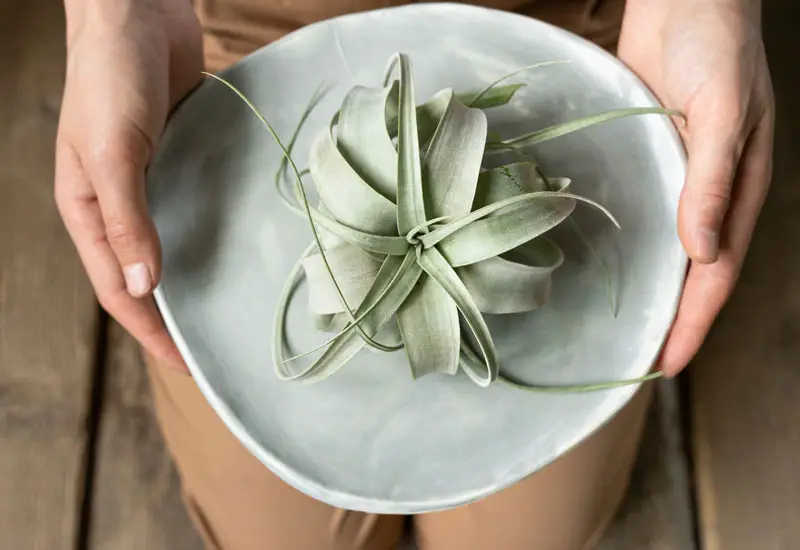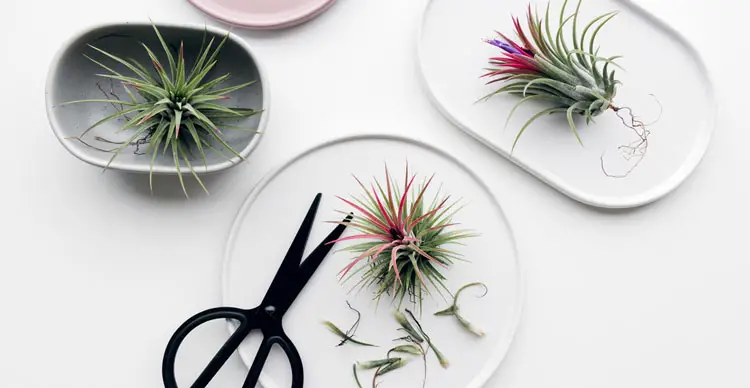How Long Do You Soak Air Plants? A Complete Watering Guide

This post follows our research editorial guidelines.

If watering indoor plants is a tricky proposition at times, watering ones with no roots is even more perplexing. Air plants (Tillandsia) often have nothing more than the most rudimentary of root systems, or no roots at all! Their most ardent fans like to soak them in water, but how do you do that safely? Is it even a viable way of watering these strange little plants?
Air plants need to have their leaves drenched in order for them to regain lost moisture. They’re evolved for humid jungle under-stories and the arid ‘cloud forests’ of the Central American highlands, where rolling fog and the morning dew are often the only moisture around. Roots mean little when the water in the air never makes it into the ground.

Table of Contents
You can keep air plants well hydrated by soaking them in clean, lukewarm water for between 15 to 30 minutes. Long neglected Tillandsias can be soaked overnight if they have become badly dehydrated. No matter what, air plants must be thoroughly drained after watering to prevent rot.
“Their roots are used solely for attachment–rather than absorbing nutrients or water via roots, air plants rely on the moisture in the atmosphere to grow and thrive,”
Carol Papas, Allegheny County Master Gardener.
The average indoor plant doesn’t get to feel rain, dew or even deep drenching humidity – that kind of living environment is pretty hostile to human comfort! But we can provide the same level of hydration by giving Tillandsias regular soakings. Like us, they find a good soak in the tub to be quite reviving!
How to Soak Air Plants
Soaking air plants is remarkably simple. All you need is a bowl and some clean water. I recommend using rainwater if you can, but filtered or distilled water is fine too.
Fill your bowl with water and put in your air plant, upside down. Give it a few good swirls in the water to clear any debris or bubbles from the leaves, then leave it to soak. 15 to 30 minutes is perfectly fine.
Once the Tillandsia has had its bath, take it out and place it upside down and allow it to drain. Water becomes readily trapped between the leaves, and it’s not uncommon for mildew or fungi to move in and cause your air plant to rot.
As soon as the air plant has dried you can put it back in its spot. Once or twice a week is fine for most varieties of air plants, though some species like a little extra now and then. In hot weather it’s not a bad idea to mist between soaks, too.
Reasons why you should soak your air plant
It’s Natural
Air plants are technically a type of bromeliad, a family of plants that have evolved to use their leaves to draw nutrition and moisture from the world around them. Their leaves are covered in fine hairs called trichomes that draw moisture and dust from the air. Once captured, the air plant can absorb them, rehydrating and nourishing themselves.
It may seem weird, but soaking takes advantage of the Tillandsias adaptations and allow it to soak up water in a way that’s natural to the genus.
It’s Easy
There’s not a lot of mucking about needed when you soak an air plant. It’s just a matter of dunking them and then leaving them. Other watering techniques involve special equipment like plant misters, or put your Tillandsia at risk of damage from chilly, poor quality tap water. If your looking for an even more care free experience try keeping your air plants in a bathroom, the heavy humidity will work wonders to keep them hydrated.
If you have a bowl and some clean water, you can soak your air plant and give it exactly the right amount of water it needs. Rainwater is best, but I generally just use tap water run through a filter jug. If it’s good enough for me to drink, it’s good enough for my air plants, too.

It’s Effective
Over watering is a common killer of indoor plants – in fact I’d say nine times out of ten, if I’ve been asked to assess a dying houseplant it’s been too much water drowning them from the root up. The rest of the time? Under watering. There’s countless how-to articles on how to water your plants, including this one, and it’s still something that even the most competent gardener fumbles from time to time.
Soaking Tillandsia totally prevents any drama with watering. You can’t underwater them, because they’re literally swimming in as much as they’d ever need. Likewise you can’t over-water them. They will only absorb what they need.
Do you soak air plants upside down?
Do you soak air plants upside down?
Air plants use their foliage to absorb water when soaking. The air plant doe not need to be kept upside down or submerged. Infract you may have troubles deciding what’s up and what’s down. Some air plants are bulbous and focus their mass in the middle. In this case, they’ll roll around in the bowl, steadfastly refusing to stay bulbous side up. So there is no need to worry about what position your air plant is when it’s being soaked, as long as it gets wet.
The main aim for placing an air plant into their bowl upside-down is to make sure all the leaf surface is submerged. The bottom part of the plant, while still capable of drawing in moisture, generally lacks the same amount of trichomes and is less effective.
To really make sure the air plant gets what it needs those leaves need to stay underwater, so for most this means upside down. For the rest, placing a saucer or small dish gently over the top ought to keep them under.
What temperature do you soak air plants in?
Air plants (Tillandsia) are tropical plants and will prefer room temperature water when soaking. Air plants evolved for the arid highlands of Central America and its lowland rainforests. They do best when they’re kept warm, and bath time is no different.
I consider a soaked plant to be having a relaxing bath, and make the water just a little warmer than air temperature. Usually I just fill the bowl and leave it in the sun for an hour or so. It warms up in no time, with exactly zero effort on my part.
Cold water also absorbs less effectively, and risks shocking the Tillandsia into dormancy. Too cold and they’ll assume the weather is turning and winter is on the way. This triggers a host of changes in the plant and can really put the breaks on growth.

Can you let an air plant soak overnight?
While generally it’s a good idea to limit your Tillandsia’s day spa trips to no more than a half an hour, really dry plants can benefit from a long soak. Dehydrated air plants spring back beautifully once they’ve had a chance to really top up the reserves.
Signs of air plant dehydration include brown leaf tips, thinning leaves, and wrinkling or puckering at the thicker base of the plant. Leaves that become papery and fall away are another key sign you need to really let the air plant soak.
So long as your home is kept reasonably warm, it’s safe to soak them overnight. Around 8 hours is ideal. I’ve also put them in at the beginning of my work day and taken them out at the end, a similar unit of time with less chance of the water becoming chilly during the midnight hours.
Can you soak air plants too long?
You don’t want to leave your air plant soaking any longer than the eight hours or so you’d leave them overnight. They are, after all, terrestrial plants. They need carbon dioxide taken from the air in order to make their food.
While they’ll tolerate a good solid soak, any longer than that and they’ll start to drown. Overnight is easily enough time for even a badly dehydrated air plant to replenish their reserves.
Soaking your air plants is the easy-care solution to watering these rootless plants, the ideal way to perk them up and plump them out. After all, who doesn’t like a nice relaxing soak in the tub?

